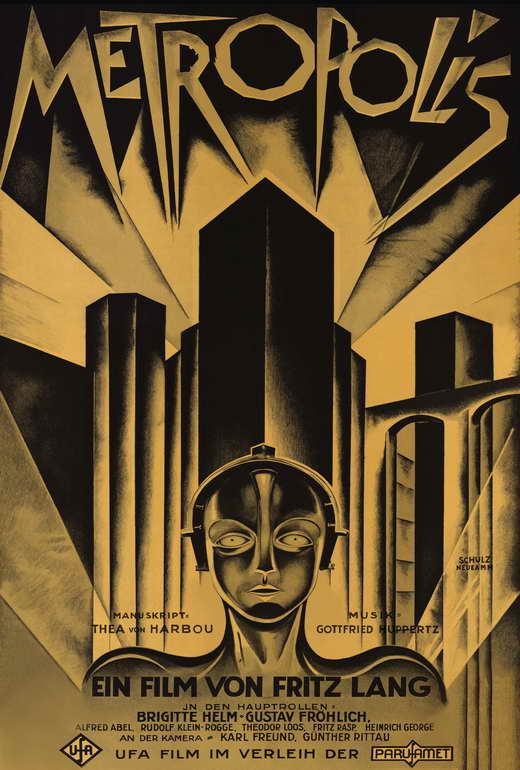Fig. 1 - Official Film Poster
Alien (1979) is a science-fiction horror film directed by Ridley Scott. The film depicts a small crew aboard a ship travelling through space to get back to earth, all seems well until they land on an unknown planet only to bring back an alien species that begins to kill off the crew one by one. The film spawned 3 sequels and has been highly successful. Part of this success is due to the shocking scenes included and the use of suspense throughout, as said by Derek Malcolm, "No film I have seen in the last year or so, excluding perhaps The Deer Hunter, emanates so strong a whiff of palpable, nerve-straining shock." (Malcolm, 2009)
As previously mentioned, Alien uses the elements of surprise to really pull the watchers into it's world. The film centers heavily around the idea of suspense and the unknown in regards to the alien itself, it is rare to see a full shot of the life form for the majority of the feature, a choice that Scott made to allow the audience to imagine it as horribly, or not, as they wanted to. This idea of never being sure of it's real form instills a real fear and uncertainty in the viewer.
Fig. 2 - The Alien
In regards to both the alien and the set design there have been countless opinions and thoughts on the idea that the entire film production alludes to both the fear of sex and in some cases, rape. The alien sets and the creature itself were designed by H. R. Giger and Veronica Cartwright - part of the cast - spoke of his designs in regards to the idea of sex, "so erotic...it's big vaginas and penises...the whole thing is like you're going inside of some sort of womb or whatever...it's sort of visceral." (Cartwright, 2003)
The film is said to portray a fear of sex due to the actions and attacks of the Alien towards the crew and the way the crew themselves act towards each other, for example, when Ash attacks Ripley. He firstly pushes her down before rolling a magazine, attempting to force it down her throat to choke her, coupled with the designs and further imagery the opinions about this are fairly well supported and agreed upon by many.
Giger's designs are highly praised and revered for their portrayal of an extraterrestrial landscape, all of the sets used during the scenes on the alien planet are full of eerie structures and organic looking materials that contrast starkly to the man-made, practical and mechanical design of the Nostromos. Brian Eggert speaks of Giger's designs paired with Scott's directing, stating, "As we writhe about in fear from Giger’s suggestive designs, the film infiltrates its audience deeper than most could ever hope to achieve, doing so with fewer characters and deliberate pacing." (Eggert, 2012)
Fig. 3 - The crew gathered around one of the Alien sets which they had nicknamed the 'Space Jockey'.
Another surprising part of Alien is it's lead, Ripley. Portrayed by Sigourney Weaver, Ripley is everything most heroines were not. She is strong, appears intelligent and rather than to scream and run her first instinct is to find out how to kill the alien, at first not even willing to allow the smaller version of the creature on to the ship. Although many believe the scene where she undresses, unaware of the Alien still aboard her escape vessel, negate all of what the character had built up during the film. It can be argued that the scene played out this way to suggest vulnerability, possibly still suggestive of the psycho-sexual nature of other aspects of the film.
Fig. 4 - The Nostromos
Much like it's predecessors, Alien (1979) utilised miniatures in it's production. Most notably with one of the opening scenes, the Nostromos flying through space in a shot that much resembles the iconic scene from George Lucas' Star Wars (1977). The use of miniatures to produce sets can also be compared to other, much older, films we've watched such as Metropolis.
Fig. 5 - (Above) Star wars (1977)
Fig. 6 - (Below) Alien (1979)
Overall, Alien is a classic horror film, with the use of suspense to keep the watcher on their toes and the designs of it's sets and creatures perfected to give an uncomfortable feeling that will unsettle most. It as Brian Eggert said,
"Made with uncommonly crafted skill to unsettle the minds and bodies of its audiences, Alien is a profoundly influential work and a lasting classic. The risks taken by this film make it a rarity, while its methods yield a paradigmatic specimen whose combination of genre thrills, bound by great artistry and innovation, have yet to be bested by imitators." (Eggert, 2012)
Bibliography:
Quotes used:
Cartwright, Veronica | 2003 | The Beast Within: The Making of Alien
Accessed on 24/10/2013
Images used:


















































